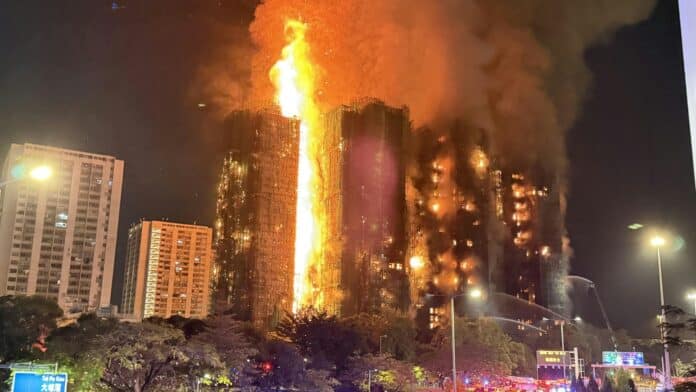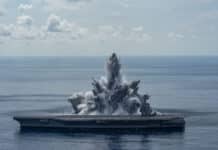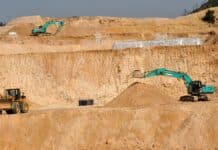Capitalist greed, cost-cutting and disregard for human life have once again caused a catastrophe
Hua Ao Man, ISA in Hong Kong
The raging fire at Tai Po’s Wang Fuk Court, which lit up half the night sky, was the deadliest fire in Hong Kong in the post-1945 era. Eighty three people are confirmed dead at the time of writing, with that number likely to rise further, and over 250 still missing. We express our deep shock, sadness and also solidarity with the survivors and victims of this tragedy, which includes thousands of homeless residents who have lost everything.
Seven of eight 32-storey buildings in the estate were engulfed in flames, which are still not fully extinguished more than a day later despite incredible efforts by over 700 firefighters, one of whom also died in the catastrophe. This raises many questions and we have zero trust in Hong Kong’s authoritarian CCP-controlled government to conduct the necessary fair, deep-going and honest investigation or to change course from today’s disastrous policies. This government only serves the interests of the big capitalists under the control of the Beijing dictatorship.
Only an independent investigation based on genuine representatives of grassroots workers, public housing tenants, emergency personnel and legal experts nominated independently of government control can do this. The authoritarian apparatus with its CCP-picked government and pseudo ‘Legislative Council’, tied to big business interests, created this disaster. Any investigation controlled by them will be a cover up and merely offer up a few hapless scapegoats and token corrections.
The disaster occurred in Wang Fuk Court, a housing estate built in the 1980s, which was home to almost 5,000 people. All eight buildings in the estate were undergoing exterior wall repairs. A fire broke out in the scaffolding and safety netting of one building in the afternoon of 26 November, and with the help of strong winds and dry weather the fire quickly spread to six other buildings. This highlights the inherently high fire risk in Hong Kong’s high-density residential environment, where people are packed like sardines into towers that are too close together. This model has always been about maximising profits for the business consortiums, reducing costs for the Scrooge-government, and ignoring or silencing the demands of Hong Kong people.
Lesson from Grenfell, London
The lightning rapid spread of the fire from one building to six others follows a similar pattern to the Grenfell Tower disaster in London in 2017, which killed 72 people. That was also caused by the use of substandard materials during renovations to the exterior walls allowing a single fire in one apartment to quickly spread and engulf the entire building. The building company in the Grenfell case saved HK$3 million HKD (£290,000) by opting to use dangerous materials. The official inquest into the Grenfell fire concluded that cost-cutting by authorities and building companies and “indifference to fire safety” was the cause of deaths.
In Tai Po, rather than exterior insulation tiles, it was the scaffolding and plastic safety netting that acted as an accelerant for the fire. Several similar fires involving scaffolding and safety netting have occurred in Hong Kong in the past month including at the University of Hong Kong’s student residence (Pok Fu Lam), a construction site at Concorde Road (Kai Tak) and the Chinachem Tower (Central). Safety netting, if meeting the required flame-retardant specifications, is theoretically extremely difficult to ignite, and even if it is ignited it will quickly extinguish itself. However, film footage from the Tai Po fire shows the safety net burning fiercely, directly causing the fire to spread rapidly.
This inevitably raises questions: Was there corruption and shoddy workmanship by the contractor, Prestige Construction & Engineering Co. Ltd.? Media reports say three people, two construction company directors and an engineering consultant, have been arrested. Did they use substandard building materials and safety nets to maximise profits? The company has a history of safety violations and corruption, having been convicted multiple times for breaches of regulations and negligence. In 2009, a shareholder was also imprisoned for bribing the Housing Society (HKHS).
Corruption and profiteering
Last year, the exorbitant repair plan for Wang Fuk Court sparked widespread discontent among residents. Reports indicated that the local Owners’ Corporation, then controlled by the pro-CCP Democratic Alliance for the Betterment and Progress of Hong Kong (DAB), adopted the most expensive repair plan, costing HK$330 million (£32 million), double the original estimate. This led to allegations of bid-rigging and in September last year angry residents demanded the Owners’ Corporation be replaced. However, because the construction contract had already been signed the residents had no choice in the matter.
In Hong Kong, bid-rigging scandals in large-scale housing estate projects are nothing new, but it is clear that under Beijing’s National Security Law imposed in 2020, the public is intimidated and reluctant to challenge the pro-CCP-establishment camp and its affiliated organizations or corporations. Of course with the crushing of democratic rights in Hong Kong these corrupt practices become more open and rampant.
Some residents stated that they couldn’t hear the fire alarm at all after the fire broke out, because “the building manager hadn’t received any training on how to activate the fire alarm.” These tragedies repeatedly expose the predatory nature of capitalism, which disregards human life and safety in its drive for profits.
In Hong Kong as in China, both under the iron heel of CCP rule, the reckless greed of capitalist companies is magnified to the extreme by a police state that crushes dissent and prohibits organised protests. Since the CCP’s Hong Kong crackdown in 2020, and imposition of its National Security Law, more than 200 trade unions have been closed down along with dozens of opposition political parties and groups. The media has been muzzled and so-called elections turned into a grotesque show of pro-CCP lackeys.
Election boycott
The next elections are scheduled for 7 December, terrible timing for the government. Chief Executive John Lee Ka-chiu has already floated the possible postponement or curtailment of these elections “to prioritise” tackling the aftermath of the fire and “helping the residents”. The real reason is the establishment’s fear that mass anger, further intensified by this disaster, could result in an even bigger election boycott than last time (2021) when less than one in three eligible voters turned out.
Hong Kong’s totalitarian capitalist nightmare is the root cause of such catastrophes as the Tai Po fire. This tragedy will now severely test the CCP’s post-2020 model of rule in Hong Kong. Will the government attempt to ban protests and gatherings? In China, the CCP heavily restricts and even bans public displays of mourning, often removing flower tributes, for fear that these could be a spark for mass protests.
Socialists and chinaworker.info demand the lifting of the authoritarian National Security Law and all repressive and anti-union laws in Hong Kong. We oppose all restrictions on public gatherings to grieve, show solidarity, and demand justice. We demand an independent public and democratically-controlled enquiry into the Wang Fuk Court disaster, and an emergency rehousing and compensation program for the victims funded by the government but controlled locally and democratically by the grassroots community. A largescale, urgent fire safety overhaul of all Hong Kong housing must be undertaken. We call for public ownership of the construction and property industry under democratic and trade union control and a root-and-branch review of housing policies to build safe and affordable public housing for the masses.
There can be no justice, no safety, under capitalism and dictatorship!




